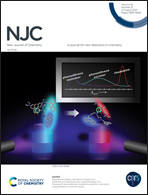Distinctive MoS2-MoP nanosheet structures anchored on N-doped porous carbon support as a catalyst to enhance the electrochemical hydrogen production†
Abstract
The construction of excellently performing electrocatalysts for hydrogen evolution reaction (HER) with a low-cost and economical strategy is still struggling with an enormous challenge in electrochemical water splitting. In this work, a novel N-doped porous carbon substrate constructed heterojunction electrocatalyst (MoS2-MoP/NC) was fabricated by a simple and facile method. Based on the electronic interaction and synergistic effect between MoS2 and MoP phases, the fabricated MoS2-MoP/NC heterojunction catalyst exhibited excellent electrocatalytic ability. In addition, the N-doped porous carbon substrate had a good charge/mass-transfer ability, which could effectively facilitate electronic transmission or prevent the aggregation of MoS2-MoP nanosheets and improve the catalytic activity. The heterojunction catalyst significantly improved HER activity with a low overpotential of 83 and 103 mV at 10 mA cm−2 in a 1.0 M KOH and 0.5 M H2SO4 and Tafel slope of 59.38 and 59.20 mV dec−1 for HER, respectively. This work provides a simple, less expensive and efficient approach for constructing high-performance heterojunction catalysts for HER.



 Please wait while we load your content...
Please wait while we load your content...